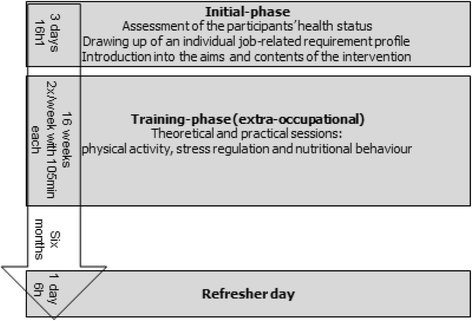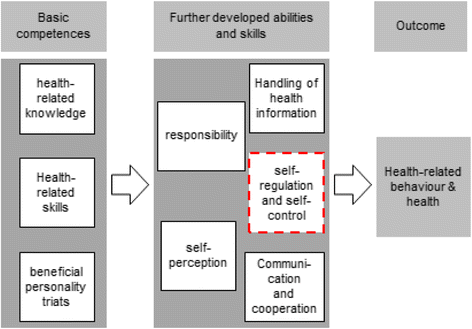Promoting physical activity and health literacy: study protocol for a longitudinal, mixed methods evaluation of a cross-provider workplace-related intervention in Germany (The AtRisk study)
- PMID: 27449188
- PMCID: PMC4957840
- DOI: 10.1186/s12889-016-3284-6
Promoting physical activity and health literacy: study protocol for a longitudinal, mixed methods evaluation of a cross-provider workplace-related intervention in Germany (The AtRisk study)
Abstract
Background: Physical activity and health literacy are topics of utmost importance in the prevention of chronic diseases. The present article describes the study protocol for evaluating a cross-provider workplace-related intervention promoting physical activity and health literacy.
Methods: The RE-AIM Framework will be the conceptual framework of the AtRisk study. A controlled natural experiment and a qualitative study will be conducted. The cross-provider intervention is based on the cooperation of the German Pension Fund Rhineland and cooperating German Statutory Health Insurances. It combines two components: a behavior-oriented lifestyle intervention and the assignment of a health coach. The single-provider intervention only includes the behavior-oriented lifestyle intervention. The quantitative study (natural experiment) encompasses three measuring points (T0 = start of the behavior-oriented lifestyle intervention (baseline); T1 = end of the behavior-oriented lifestyle intervention (16 weeks); T2 = 6 month follow-up) and will compare the effectiveness of the cross-provider workplace-related intervention compared with the single provider intervention. Participants are employees with health related risk factors. ANCOVA will be used to evaluate the effect of the intervention on the outcome variables leisure time physical (primary outcome) activity and health literacy (secondary outcome). The qualitative study comprises semi-structured interviews, systematic field notes of stakeholder meetings and document analyses.
Discussion: The AtRisk study will contribute towards the claim for cross-provider interventions and workplace-related approaches described in the new Preventive Health Care Act. The results of this study will inform providers, payers and policy makers about the effectiveness of a cross-provider workplace-related lifestyle intervention compared to a single-provider intervention. Beyond, the study will identify challenges for implementing cross-provider preventive interventions. With respect to the sustainability of preventive interventions the AtRisk study will give insight in the expectations and needs on health coaching from the perspective of different stakeholders.
Trial registration: DRKS00010693 .
Keywords: Cross-provider; Health literacy; Health promotion; Physical activity; Workplace.
Figures
References
-
- World Health Organization (WHO) Global Status Report on Noncommunicable Diseases 2010. Geneva: World Health Organization; 2011.
-
- Bishop K, Phillips A, Thow AM. Chronic disease and participation in work. Canberra: Australian Institute of Health and Welfare; 2009.
-
- Center for Disease Control and Prevention. The Power of Prevention. Chronic disease… the public health challenge of the 21st century; 2009.
MeSH terms
Associated data
LinkOut - more resources
Full Text Sources
Other Literature Sources
Medical




